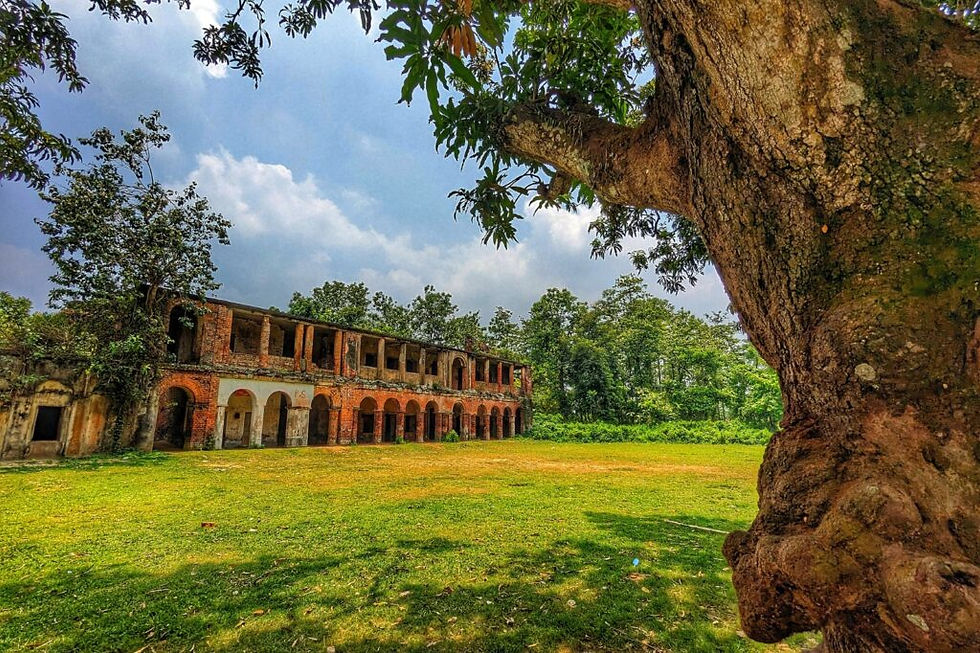Neelkuthi: Echoes of Colonial Indigo Production
- Niharika Momtaz

- Aug 27
- 3 min read

Dotting the rural landscape of Bengal, the crumbling walls of indigo factories—Neelkuthi in the local tongue—bear mute testimony to the exploitative machinery of colonial rule. Their battered façades recount an era when the British East India Company and European investors turned the indigo shrub into sovereign currency, cascading the labor of Bengali cultivators into debt and despair. Past the peeling plaster and rusted vats, the buildings serve both as ghostly monuments and as memorials to the peasant revolts and quiet endurance that contested the empire.
Indigo’s Colonial Boom
The late 1700s and early 1800s witnessed indigo’s rapid ascent in the global textile economy, its tar-stained dye victualing the booming European appetite for richly saturated cottons. Alert to the profit shimmering in the pigment, British planters advanced into Bengal’s villages, corralling the local farmers into cycles of multiple borrowing for seed and then weaving the debt into the warp of imperial rule. The Neelkuthi complexes that arose were far from mere dye pits: they were citadels of coercive agronomy, fortified by contract, overseer, and gun. The same vats that turned the leafy shrub azure also concealed the sweat and sorrow that dyed Bengal itself.
At first, the East India Company tempted ryots—local farmers—into growing indigo by offering loans and advances. The deal soured fast. Farmers landed unable to escape tight contracts and watched their wages vanish. They traded food crops for the dye and watched their land wither while they starved.
Exploitation of the Peasantry
The rules were ruthless. Loans turned into chains when they insisted peasants repay swollen interest rates from meager indigo yields. When ryots refused to bend, they were bullied by thugs, dragged into courts, or dragged to jail. The indigo sapped the soil’s strength, leaving nothing for millet or rice when the season turned. The ryot’s villages slid into despair while factory owners in Europe stacked up profits from the traded dye.
The indigo factories stood as brutal reminders of this system. Stolid, windowless grey buildings, they rose beside rivers and railway lines to hoard and boil the crop. The locals called them Neelkuthis and saw them as more than sheds; they were towers of fear and symbols of a foreign grip tightening around their throats.
The Indigo Revolt of 1859-60
After years of crushing exploitation, Bengal’s peasants finally rose as one. The Indigo Revolt, or Nil Bidroho, ignited in 1859 when thousands of farmers across the region refused to plant one more row of blue dye. The colonial planters pressed hard, but the villages rang with the same fierce resolution: “We will not grow indigo anymore.” The refusal spread like fire, igniting one community after another.
The revolt astonished everyone with its size and solidarity. Guided by village leaders, some sympathetic zamindars, and early Bengali intellectuals, the peasants stood firm against the entire colonial order. Bengali newspapers, street plays, and leaflets broadcast their conditions, reaching sympathetic urban ears. Even when the British sent in troops and the blood ran red, the movement forced the imperial officials to listen. The Indigo Commission of 1860 catalogued the planters’ crimes, the report bending the colonial will to limit the crop, and indigo’s grip on Bengal began to loosen.
Neelkuthi as Historical Ruins
A century and more later, the old neelkuthis still dot the countryside of present-day Bangladesh—ghosts of the blue harvests in Kushtia, Sirajganj, Pabna, and Rajshahi. Their cracked facades, shattered arches, and weed-choked yards speak in the still air. Ruins, yes, but living ruins: a testament to the strength of men and women who refused to be dyed blue.
While a few indigo factories have been cared for as heritage sites, countless others fall to ruin in silence, their stories untold. Yet, these decaying walls are priceless for anyone trying to grasp the economic, social, and political battles of colonial Bengal. They are more than piles of brick and mortar; they are monuments of memory, honoring the small farmers whose sacrifices fought against oppression.
Legacy and Reflection
The tale of the indigo factories runs deeper than profit; it lays bare the human cost of colonial greed. The Neelkuthis stand as stark reminders of the balance of power tilted toward profit at the expense of human lives. Yet they also quietly echo the unwavering spirit of resistance, for the farmers rose against vast colonial power, fully aware of the danger.
When we remember the indigo factories, we confront a painful chapter, and yet we are also stirred by the courage of those who fought back. Our duty to protect these ruins goes beyond history; they are living proof of bravery, urging tomorrow’s leaders to remember the struggles that ultimately led the subcontinent to freedom.




Comments